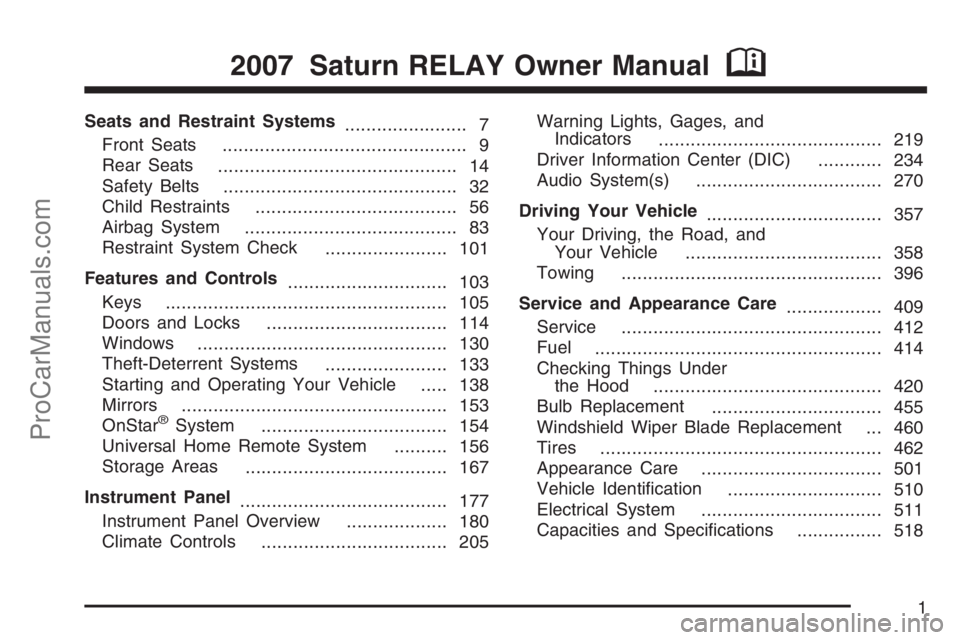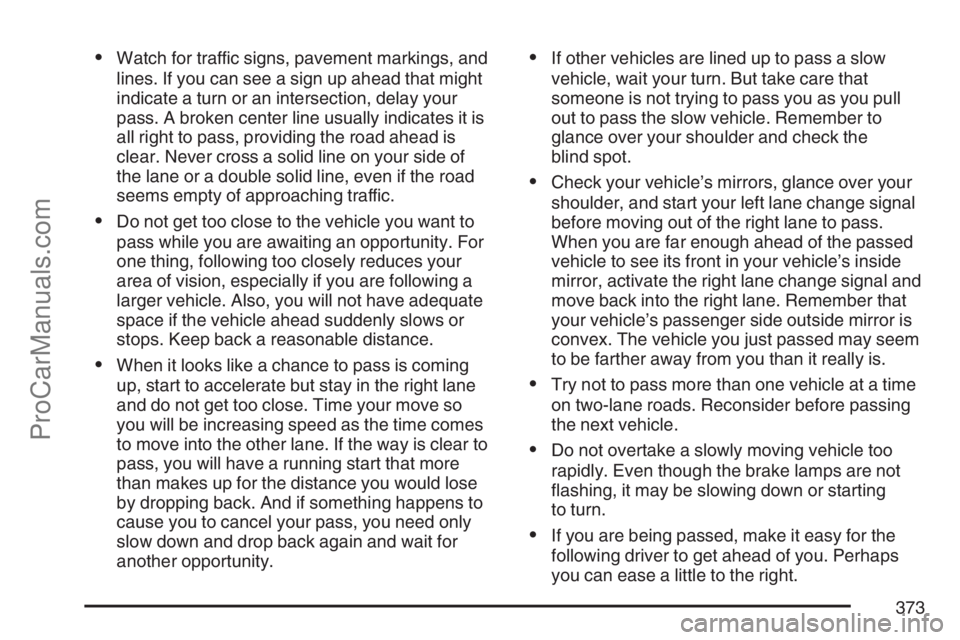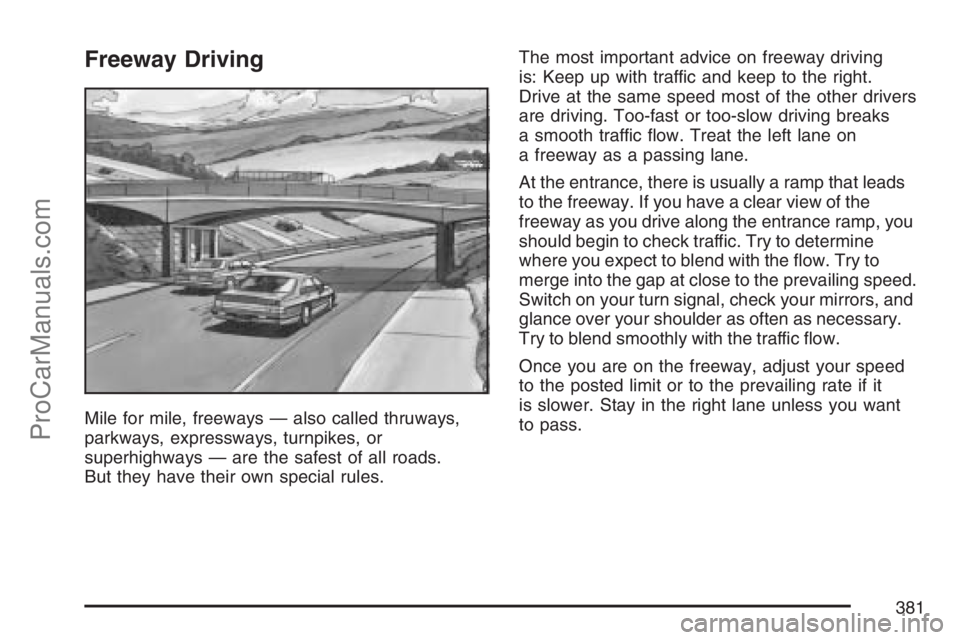mirror SATURN RELAY 2007 Owners Manual
[x] Cancel search | Manufacturer: SATURN, Model Year: 2007, Model line: RELAY, Model: SATURN RELAY 2007Pages: 570, PDF Size: 3.41 MB
Page 1 of 570

Seats and Restraint Systems
....................... 7
Front Seats
.............................................. 9
Rear Seats
............................................. 14
Safety Belts
............................................ 32
Child Restraints
...................................... 56
Airbag System
........................................ 83
Restraint System Check
....................... 101
Features and Controls
.............................. 103
Keys
..................................................... 105
Doors and Locks
.................................. 114
Windows
............................................... 130
Theft-Deterrent Systems
....................... 133
Starting and Operating Your Vehicle
..... 138
Mirrors
.................................................. 153
OnStar
®System
................................... 154
Universal Home Remote System
.......... 156
Storage Areas
...................................... 167
Instrument Panel
....................................... 177
Instrument Panel Overview
................... 180
Climate Controls
................................... 205Warning Lights, Gages, and
Indicators
.......................................... 219
Driver Information Center (DIC)
............ 234
Audio System(s)
................................... 270
Driving Your Vehicle
................................. 357
Your Driving, the Road, and
Your Vehicle
..................................... 358
Towing
................................................. 396
Service and Appearance Care
.................. 409
Service
................................................. 412
Fuel
...................................................... 414
Checking Things Under
the Hood
........................................... 420
Bulb Replacement
................................ 455
Windshield Wiper Blade Replacement
... 460
Tires
..................................................... 462
Appearance Care
.................................. 501
Vehicle Identi�cation
............................. 510
Electrical System
.................................. 511
Capacities and Speci�cations
................ 518
2007 Saturn RELAY Owner ManualM
1
ProCarManuals.com
Page 104 of 570

Mirrors......................................................... 153
Manual Rearview Mirror............................. 153
Outside Power Mirrors............................... 153
Outside Convex Mirror............................... 154
Outside Heated Mirrors............................. 154
OnStar
®System.......................................... 154
Universal Home Remote System................ 156
Universal Home Remote System
(With Three Round LED)....................... 156
Universal Home Remote System
(With One Triangular LED)..................... 157
Universal Home Remote System
Operation (With Three Round LED)....... 158
Universal Home Remote System
Operation (With One Triangular LED)..... 163Storage Areas............................................. 167
Glove Box................................................. 167
Cupholder(s).............................................. 167
Overhead Console (With Rail)................... 168
Overhead Console (Without Rail)............... 170
Floor Console Storage Area...................... 170
Folding Tray.............................................. 170
Second Row Center Console.................... 171
Luggage Carrier........................................ 172
Convenience Net (With Hideaway
Rear Storage Bins)................................ 173
Convenience Net (Without Hideaway
Rear Storage Bins)................................ 173
Hideaway Rear Storage Bins..................... 174
Section 2 Features and Controls
104
ProCarManuals.com
Page 132 of 570

Power Rear Quarter Windows
Your vehicle may have power rear quarter
windows.
This switch, located in
the overhead console
switchbank, is used
for opening and closing
the power rear
quarter windows.
Press the top of the switch to open the windows;
both windows will open. The windows will
continue to open as long as the switch is pressed,
until they are fully opened.
Press the bottom of the switch to close both
windows. The windows can be closed fully or
partially, depending on how long the switch
is pressed.The ignition must be in RUN, ACCESSORY, or
Retained Accessory Power (RAP) must be active,
to use the power rear quarter windows. See
Retained Accessory Power (RAP) on page 139.
Sun Visors
To block out glare, swing down the sun visors.
You can also remove them from the center mount
and swing them to the side. The sun visors can
also slide along the rod to cover different areas of
the front window.
Visor Vanity Mirror
Your vehicle may have a visor vanity mirror. Pull
down the sun visor to access the vanity mirror.
Lighted Vanity Mirror
Your vehicle may have a lighted vanity mirror.
Pull down the sun visor and �ip up the cover to
expose the vanity mirror. The lamps will come on
when you �ip up the cover.
132
ProCarManuals.com
Page 153 of 570

Mirrors
Manual Rearview Mirror
While sitting in a comfortable driving position,
adjust the mirror so you can see clearly behind
your vehicle. Grip the mirror in the center to move
it up or down and side to side. The day/night
adjustment can lessen glare from the headlamps
behind your vehicle. Pull the tab forward for
daytime use; push it back for night use.
Outside Power Mirrors
The controls, located
on the driver’s door,
operate both outside
rearview mirrors.Push the top control to the left or right to choose
either the driver’s or passenger’s outside
rearview mirror. Leave the control in the center
position to prevent moving the mirrors once
they are adjusted.
Use the arrows on the bottom control to adjust the
position of each mirror. Adjust each mirror so
that you can see the side of your vehicle and the
area behind it, while sitting in a comfortable
driving position.
Both outside mirrors can be folded forward or
rearward to prevent damage when going through
car washes or con�ned spaces.
153
ProCarManuals.com
Page 154 of 570

Outside Convex Mirror
{CAUTION:
A convex mirror can make things (like
other vehicles) look farther away than
they really are. If you cut too sharply into
the right lane, you could hit a vehicle on
your right. Check your inside mirror or
glance over your shoulder before
changing lanes.
The passenger’s side mirror is convex. A convex
mirror’s surface is curved so more can be
seen from the driver’s seat. It also makes things
appear farther away than they really are.
Outside Heated Mirrors
If equipped, the outside heated rearview mirrors
are activated when the rear window defogger
is turned on. See “Rear Window Defogger”
inClimate Control System on page 205or
Dual Climate Control System on page 209.
OnStar®System
OnStar®uses several innovative technologies and
live advisors to provide you with a wide range
of safety, security, information, and convenience
services. If your airbags deploy, the system is
designed to make an automatic call to OnStar
®
Emergency where we can request emergency
services be sent to your location. If you lock
your keys in the vehicle, call OnStar
®at
1-888-4-ONSTAR and they can send a signal
to unlock your doors. If you need roadside
assistance, press the OnStar
®button and they
can contact Roadside Service for you.
154
ProCarManuals.com
Page 373 of 570

Watch for traffic signs, pavement markings, and
lines. If you can see a sign up ahead that might
indicate a turn or an intersection, delay your
pass. A broken center line usually indicates it is
all right to pass, providing the road ahead is
clear. Never cross a solid line on your side of
the lane or a double solid line, even if the road
seems empty of approaching traffic.
Do not get too close to the vehicle you want to
pass while you are awaiting an opportunity. For
one thing, following too closely reduces your
area of vision, especially if you are following a
larger vehicle. Also, you will not have adequate
space if the vehicle ahead suddenly slows or
stops. Keep back a reasonable distance.
When it looks like a chance to pass is coming
up, start to accelerate but stay in the right lane
and do not get too close. Time your move so
you will be increasing speed as the time comes
to move into the other lane. If the way is clear to
pass, you will have a running start that more
than makes up for the distance you would lose
by dropping back. And if something happens to
cause you to cancel your pass, you need only
slow down and drop back again and wait for
another opportunity.
If other vehicles are lined up to pass a slow
vehicle, wait your turn. But take care that
someone is not trying to pass you as you pull
out to pass the slow vehicle. Remember to
glance over your shoulder and check the
blind spot.
Check your vehicle’s mirrors, glance over your
shoulder, and start your left lane change signal
before moving out of the right lane to pass.
When you are far enough ahead of the passed
vehicle to see its front in your vehicle’s inside
mirror, activate the right lane change signal and
move back into the right lane. Remember that
your vehicle’s passenger side outside mirror is
convex. The vehicle you just passed may seem
to be farther away from you than it really is.
Try not to pass more than one vehicle at a time
on two-lane roads. Reconsider before passing
the next vehicle.
Do not overtake a slowly moving vehicle too
rapidly. Even though the brake lamps are not
�ashing, it may be slowing down or starting
to turn.
If you are being passed, make it easy for the
following driver to get ahead of you. Perhaps
you can ease a little to the right.
373
ProCarManuals.com
Page 375 of 570

While driving on a surface with reduced traction,
try your best to avoid sudden steering, acceleration,
or braking, including reducing vehicle speed by
shifting to a lower gear. Any sudden changes could
cause the tires to slide. You may not realize the
surface is slippery until your vehicle is skidding.
Learn to recognize warning clues — such as
enough water, ice, or packed snow on the road to
make a mirrored surface — and slow down when
you have any doubt.
Remember: Any Anti-Lock Brake System (ABS)
helps avoid only the braking skid.
Driving at Night
Night driving is more dangerous than day driving.
One reason is that some drivers are likely to
be impaired — by alcohol or drugs, with night
vision problems, or by fatigue.
Here are some tips on night driving.
Drive defensively.
Do not drink and drive.
Adjust the inside rearview mirror to reduce
the glare from headlamps behind you.
Since you cannot see as well, you may need
to slow down and keep more space between
you and other vehicles.
Slow down, especially on higher speed roads.
Your vehicle’s headlamps can light up only so
much road ahead.
In remote areas, watch for animals.
If you are tired, pull off the road in a safe
place and rest.
No one can see as well at night as in the daytime.
But as we get older these differences increase.
A 50-year-old driver may require at least twice as
much light to see the same thing at night as a
20-year-old.
What you do in the daytime can also affect your
night vision. For example, if you spend the
day in bright sunshine you are wise to wear
sunglasses. Your eyes will have less trouble
adjusting to night. But if you are driving, do not
wear sunglasses at night. They may cut down on
glare from headlamps, but they also make a
lot of things invisible.
375
ProCarManuals.com
Page 381 of 570

Freeway Driving
Mile for mile, freeways — also called thruways,
parkways, expressways, turnpikes, or
superhighways — are the safest of all roads.
But they have their own special rules.The most important advice on freeway driving
is: Keep up with traffic and keep to the right.
Drive at the same speed most of the other drivers
are driving. Too-fast or too-slow driving breaks
a smooth traffic �ow. Treat the left lane on
a freeway as a passing lane.
At the entrance, there is usually a ramp that leads
to the freeway. If you have a clear view of the
freeway as you drive along the entrance ramp, you
should begin to check traffic. Try to determine
where you expect to blend with the �ow. Try to
merge into the gap at close to the prevailing speed.
Switch on your turn signal, check your mirrors, and
glance over your shoulder as often as necessary.
Try to blend smoothly with the traffic �ow.
Once you are on the freeway, adjust your speed
to the posted limit or to the prevailing rate if it
is slower. Stay in the right lane unless you want
to pass.
381
ProCarManuals.com
Page 382 of 570

Before changing lanes, check your mirrors.
Then use your turn signal.
Just before you leave the lane, glance quickly
over your shoulder to make sure there is not
another vehicle in your blind spot.
Once you are moving on the freeway, make
certain you allow a reasonable following distance.
Expect to move slightly slower at night.
When you want to leave the freeway, move to the
proper lane well in advance. If you miss your
exit, do not, under any circumstances, stop and
back up. Drive on to the next exit.
The exit ramp can be curved, sometimes quite
sharply. The exit speed is usually posted.
Reduce your speed according to your
speedometer, not to your sense of motion.
After driving for any distance at higher speeds,
you may tend to think you are going slower
than you actually are.Before Leaving on a Long Trip
Make sure you are ready. Try to be well rested.
If you must start when you are not fresh — such
as after a day’s work — do not plan to make
too many miles that �rst part of the journey. Wear
comfortable clothing and shoes you can easily
drive in.
Is your vehicle ready for a long trip? If you keep it
serviced and maintained, it is ready to go. If it
needs service, have it done before starting out.
Of course, you will �nd experienced and able
service experts at Saturn retailers all across
North America. They will be ready and willing to
help if you need it.
382
ProCarManuals.com
Page 383 of 570

Here are some things you can check before a trip:
Windshield Washer Fluid:Is the reservoir
full? Are all windows clean inside and outside?
Wiper Blades:Are they in good shape?
Fuel, Engine Oil, Other Fluids:Have you
checked all levels?
Lamps:Are they all working? Are the lenses
clean?
Tires:They are vitally important to a safe,
trouble-free trip. Is the tread good enough
for long-distance driving? Are the tires
all in�ated to the recommended pressure?
Weather Forecasts:What is the weather
outlook along your route? Should you
delay your trip a short time to avoid a major
storm system?
Maps:Do you have up-to-date maps?
Highway Hypnosis
Is there actually such a condition as highway
hypnosis? Or is it just plain falling asleep at the
wheel? Call it highway hypnosis, lack of
awareness, or whatever.
There is something about an easy stretch of road
with the same scenery, along with the hum of the
tires on the road, the drone of the engine, and the
rush of the wind against the vehicle that can make
you sleepy. Do not let it happen to you! If it does,
your vehicle can leave the road in less than a
second, and you could crash and be injured.
What can you do about highway hypnosis?
First, be aware that it can happen.
Then here are some tips:
Make sure your vehicle is well ventilated, with
a comfortably cool interior.
Keep your eyes moving. Scan the road ahead
and to the sides. Check your mirrors and your
instruments frequently.
If you get sleepy, pull off the road into a rest,
service, or parking area and take a nap, get
some exercise, or both. For safety, treat
drowsiness on the highway as an emergency.
383
ProCarManuals.com